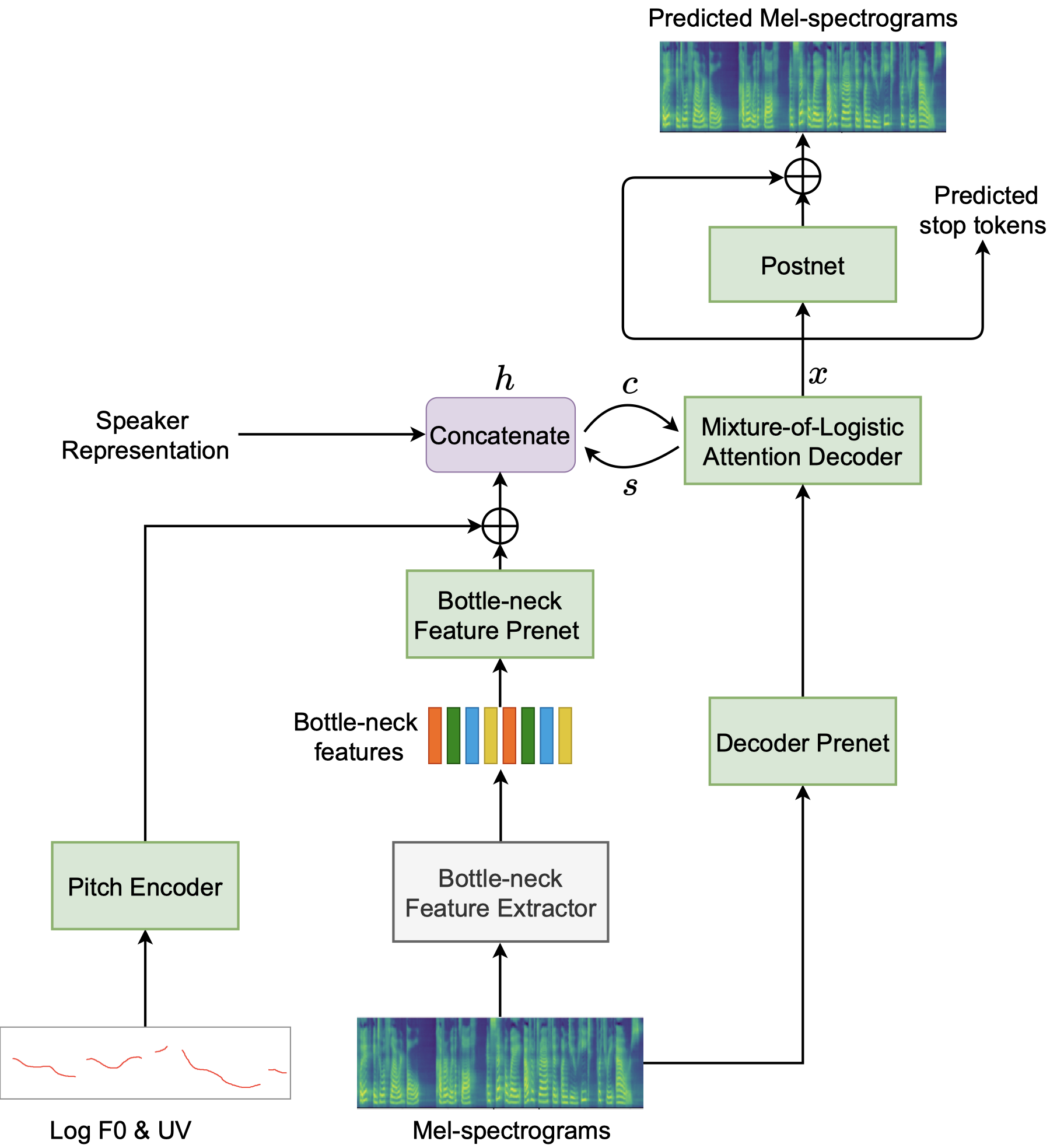One-shot Phonetic PosteriorGram (PPG)-Based Voice Conversion (PPG-VC): Any-to-Many Voice Conversion with Location-Relative Sequence-to-Sequence Modeling (TASLP 2021)
This paper proposes an any-to-many location-relative, sequence-to-sequence (seq2seq) based, non-parallel voice conversion approach. In this approach, we combine a bottle-neck feature extractor (BNE) with a seq2seq based synthesis module. During the training stage, an encoder-decoder based hybrid connectionist-temporal-classification-attention (CTC-attention) phoneme recognizer is trained, whose encoder has a bottle-neck layer. A BNE is obtained from the phoneme recognizer and is utilized to extract speaker-independent, dense and rich linguistic representations from spectral features. Then a multi-speaker location-relative attention based seq2seq synthesis model is trained to reconstruct spectral features from the bottle-neck features, conditioning on speaker representations for speaker identity control in the generated speech. To mitigate the difficulties of using seq2seq based models to align long sequences, we down-sample the input spectral feature along the temporal dimension and equip the synthesis model with a discretized mixture of logistic (MoL) attention mechanism. Since the phoneme recognizer is trained with large speech recognition data corpus, the proposed approach can conduct any-to-many voice conversion. Objective and subjective evaluations shows that the proposed any-to-many approach has superior voice conversion performance in terms of both naturalness and speaker similarity. Ablation studies are conducted to confirm the effectiveness of feature selection and model design strategies in the proposed approach. The proposed VC approach can readily be extended to support any-to-any VC (also known as one/few-shot VC), and achieve high performance according to objective and subjective evaluations.
Diagram of the BNE-Seq2seqMoL system.
This repo implements an updated version of PPG-based VC models.
Notes:
-
The PPG model provided in
conformer_ppg_modelis based on Hybrid CTC-Attention phoneme recognizer, trained with LibriSpeech (960hrs). PPGs have frame-shift of 10 ms, with dimensionality of 144. This modelis very much similar to the one used in this paper. -
This repo uses Hifi-GAN V1 as the vocoder model, sampling rate of synthesized audio is 24kHz.
- We provide an audio sample uttered by Barack Obama (link), you can convert any voice into Obama's voice using this sample as reference. Please have a try!
- BNE-Seq2seqMoL One-shot VC model are uploaded (link)
- BiLSTM-based One-shot VC model are uploaded (link)
$ cd tools
$ make
Note: If you want to specify Python version, CUDA version or PyTorch version, please run for example:
$ make PYTHON=3.7 CUDA_VERSION=10.1 PYTORCH_VERSION=1.6
- Download a model from here, we recommend to first try the model
bneSeq2seqMoL-vctk-libritts460-oneshot. Put the config file and the checkpoint file in a folder<model_dir>. - Prepare a source wav directory
<source_wav_dur>, where the wavs inside are what you want to convert. - Prepare a reference audio sample (i.e., the target voice you want convert to)
<ref_wavpath>. - Run
test.shas:
sh test.sh <model_dir>/seq2seq_mol_ppg2mel_vctk_libri_oneshotvc_r4_normMel_v2.yaml <model_dir>/best_loss_step_304000.pth \
<source_wav_dir> <ref_wavpath>
The converted wavs are saved in the folder vc_gen_wavs.
Activate the virtual env py source tools/venv/bin/activate, then:
- Please run
1_compute_ctc_att_bnf.pyto compute PPG features. - Please run
2_compute_f0.pyto compute fundamental frequency. - Please run
3_compute_spk_dvecs.pyto compute speaker d-vectors.
- Please refer to
run.sh
If you use this repo for your research, please consider of citing the following related papers.
@ARTICLE{liu2021any,
author={Liu, Songxiang and Cao, Yuewen and Wang, Disong and Wu, Xixin and Liu, Xunying and Meng, Helen},
journal={IEEE/ACM Transactions on Audio, Speech, and Language Processing},
title={Any-to-Many Voice Conversion With Location-Relative Sequence-to-Sequence Modeling},
year={2021},
volume={29},
number={},
pages={1717-1728},
doi={10.1109/TASLP.2021.3076867}
}
@inproceedings{Liu2018,
author={Songxiang Liu and Jinghua Zhong and Lifa Sun and Xixin Wu and Xunying Liu and Helen Meng},
title={Voice Conversion Across Arbitrary Speakers Based on a Single Target-Speaker Utterance},
year=2018,
booktitle={Proc. Interspeech 2018},
pages={496--500},
doi={10.21437/Interspeech.2018-1504},
url={http://dx.doi.org/10.21437/Interspeech.2018-1504}
}
